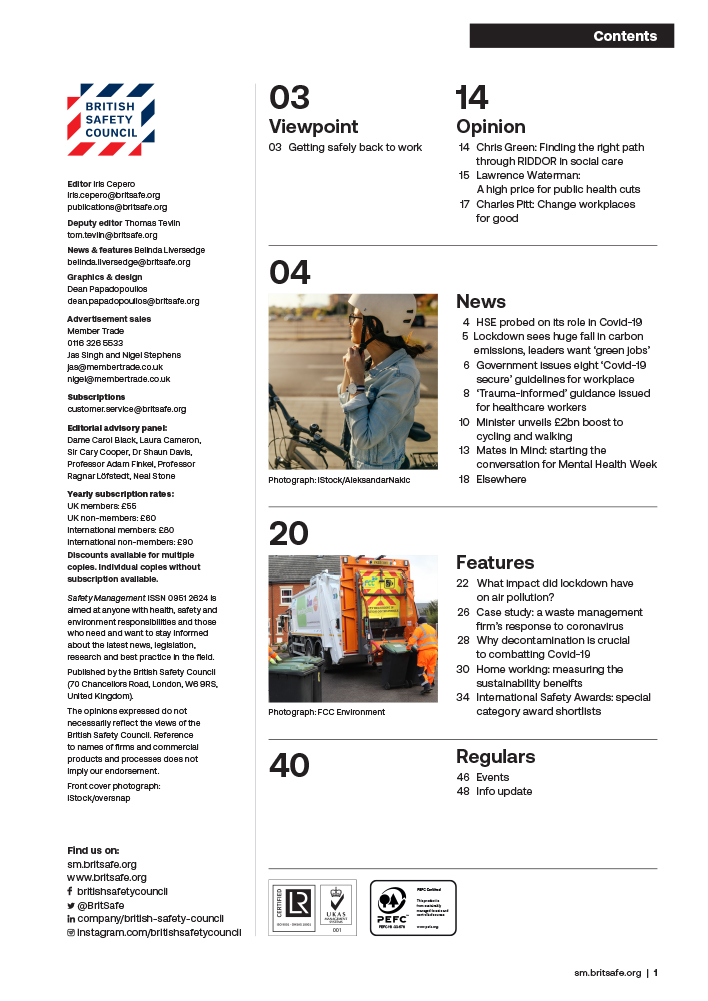A new ‘gateway’ approval process aims to ensure the safety of certain high-rise residential buildings in Britain.
Features
The gateways to building safety
In June 2022, the government introduced the Building Safety Act, 2022 which paved the way for the Health and Safety Executive (HSE) to establish a new Building Safety Regulator.
The Building Safety Regulator (BSR) will provide oversight of the entire built environment, raise standards for building safety across industry and deliver the new regulatory regime for high-rise residential buildings (HRBs). HRBs are defined under the Act as buildings at least 18 metres or seven storeys in height.
The new regime places residents’ safety at its heart and will drive a real shift in industry standards. Those who manage building safety need to start thinking about their buildings holistically and how they can ensure they remain safe for the people who live in them.
What is changing
Tackling poor design for tall residential buildings or HRBs right from the onset of a project’s life, is a direct response to Dame Judith Hackitt’s recommendations in her Building a Safer Future report, published in May 2018. HSE will require assurance before building work can commence; before a building can be certified complete; and of course, before a building can be occupied. Photograph: iStock
HSE will require assurance before building work can commence; before a building can be certified complete; and of course, before a building can be occupied. Photograph: iStock
The Building Safety Act, 2022 features ‘hold points’, known as gateways – and this means that acting as a guardian for building safety, HSE will require assurance before building work can commence; before a building can be certified complete; and of course, before a building can be occupied.
These perceived ‘changes’ are not new, but they are not ‘business as usual’ either. What these changes are is a case of business as it should be done. Procedures may be changing, but the functional requirements of building regulations will remain the same.
The difference here is that BSR will have the ability, and a duty, to challenge the safety of a building through the entire process; from the initial design phase through to occupancy. This will ensure that when a building is being designed, it is designed with the utmost safety in mind and reflected equally in the construction phase. Without this assurance, BSR will have to intervene.
Making your application count
From October 2023, if you’re developing a high-rise building in England (a building at least 18 metres or seven storeys in height), then you must apply for building control approval from BSR. The biggest change you will notice is the information we require from you will be significantly more comprehensive and will be requested at a much earlier stage. You cannot begin building work until BSR has given you its approval.
The new regulator will be assessing design assumptions to ensure they are realistic, risks have been identified, measures to mitigate these risks are in place, and that the design is based on appropriate guidance to meet functional requirements. Put simply, a building cannot be built without BSR’s official approval that occupants of the building will be safe.
The better the quality your application is, the more straightforward it will be for BSR to evaluate. If BSR is not provided with the necessary information, it will not be their job to decipher or locate it. A building control approval application should be thorough and contain all the relevant information, enabling BSR to determine whether a design will meet the functional requirements of building regulations effectively. There are many challenges that stem from the lack of complete, accurate and maintained building information. So, it is your responsibility and opportunity to demonstrate to the regulator how safety will be implemented.
 The better the quality your application is, the more straightforward it will be for BSR to evaluate. Photograph: iStock
The better the quality your application is, the more straightforward it will be for BSR to evaluate. Photograph: iStock
The regulator will work with you at every step of the way but it’s important to stress that ultimately, BSR can only assess the information they’re provided with, and a decision will be given as quickly as possible within the statutory time period.
Now, let’s discuss how the new process will work.
Planning Gateway One (PGO)
There will be two key elements to this stage of the process, the first is that HSE is established as a statutory consultee of local planning authorities for fire safety. The second is that applicants will be asked to provide a fire statement, outlining the specific considerations made regarding fire safety in the development, for HSE to review and raise any concerns with the local planning authority.
To support you with this process, we will offer a free pre-application service for advice on fire safety design, to help developers resolve any issues before they submit their planning applications. We have already seen great success with this service, with a number of plans being amended based on our feedback. These successes demonstrate that the PGO process is already raising standards for the industry, which will ultimately lead to safer buildings.
Gateway Two
This stage will see a rigorous inspection of building regulations come into full effect, ensuring that building safety is considered at each stage of the design and construction process. It is worth repeating that the higher the quality of an application, the quicker BSR can make an assessment. The regulator will be stepping in earlier in the design process and implementing a more robust evaluation. For example, if your plan states that sprinklers will not be installed in certain areas, then you must provide a clear explanation for this.
On top of a comprehensive outline of the work that will be carried out and the required information about the building itself, your application should also contain information about the people involved in the building, such as the client, principal contractor and principal designer. You will also need to set out standard building information, such as the site location plan and boundaries.
 Colin Blatchford-Brown is Operational Policy Lead for Gateways & Building Control at HSE. Photograph: HSE
Colin Blatchford-Brown is Operational Policy Lead for Gateways & Building Control at HSE. Photograph: HSE
It is likely that a new set of prescribed documents will be required, and these are expected to include:
- A design and build approach (so you can show how your design meets functional requirements); and
- A construction control plan (so you can demonstrate how building safety and Building Regulation compliance will be maintained throughout the construction phase, and how change will be managed).
After approval
BSR will be looking for unresolved design issues, ensuring that regulations are applied appropriately with the support of submitted documentation. It goes without saying that this approach will be the same for everyone.
Once building control approval is received, works can begin on site. BSR will agree on an inspection schedule with you, which will provide the basis for on-site review and the mechanism for the regulator to ensure that what has been approved is reflected in what is being built. An inspection of the finished work will form part of this.
The concept of the inspection schedule is not new and BSR will be applying a similar schedule, which will include on-site inspections at key stages throughout the construction phase. The significant change with this regime is that BSR will have additional checks to conduct, including a change control log, to help inform our assessment on whether any unauthorised design changes have been made during the construction phase.
It is important that there is continuous dialogue throughout the process, to ensure that when it is time to apply for a completion certificate, BSR is fully aware of the project’s history, and all parties are ready for the next phase.
Gateway Three
A vital stage of the process, Gateway Three will introduce a hold point at the completion of a project before occupation can occur. This allows the safety of future occupants to remain the highest priority, as construction comes to an end. This is an important part of the new regulatory framework, ensuring that the regulator has the required information to issue a completion certificate.
The planning for this stage starts at the beginning of the building control process, to ensure that a programme is in place to allow the collection of all necessary information, right from the start. This is the ‘Golden Thread’ of building information. It is essential that commissioning and certification is scheduled well in advance, so it coincides with the submission of the completion certificate application.
At this point, BSR will undertake a statutory consultation with the fire and rescue service and review relevant prescribed documents. As mentioned, it is crucial that dialogue with the regulator is ongoing throughout the construction phase, so there should be no surprises at this point. The change control process will have recorded any changes made from the original building control approval, and any changes requiring re-approval will be logged and evidenced.
For the completion certificate to be approved, there must be sufficient evidence to support that what was built reflects the approved plans, and the requirements of the building regulations have been met. Once BSR receives this information, the application will be processed as swiftly as possible, so as not to cause undue delay. This is why incorporating this stage of the process into your overall programme timeline is critical. Of course, as already mentioned, the quality of the submission will have a bearing on the time required to assess and approve. BSR hopes that consistent and open communication throughout the entire construction phase will avoid any areas of concern at this stage.
Building registration and occupancy
The final step in the process is building registration. The new regime identifies new duty holders who will be known as ‘accountable persons’ (APs). This will be the organisation or person who owns or has responsibility for the building. If a building has more than one AP, the AP responsible for the structure and exterior of the building will be the principal accountable person (PAP).
PAPs will need to obtain a completion certificate before they can apply to register the building with the BSR, and until building registration has been actioned the building must remain unoccupied.
From April 2024, the BSR will begin a programme to invite the PAP for each registered building to apply for a building assessment certificate. Buildings will then be reassessed every five years at minimum to ensure they are being managed and maintained effectively.
Summary
We strongly urge you to consider the evidence and justifications that you provide during the first stages of building control approval – and encourage you to maintain a consistent dialogue with BSR throughout every stage of the build.
Remember that your design needs to comply with functional requirements, and also, the more information you provide, the more informed BSR’s decision will be.
To get the latest news and updates on future building safety regulations subscribe to the BSR e-bulletin here
Colin Blatchford-Brown is Operational Policy Lead for Gateways & Building Control at HSE



